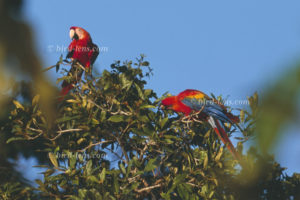 As the name suggests high precipitation characterizes the rainforests. Photographing animals during the rain is a real challenge to people and material. But this particular weather situation gives many motifs an additional charm. An extensive downpour is always a great moment to spot birds in an extraordinary situation. But also the small representatives of the animal kingdom such as frogs, butterflies, insects are hardly to be surpassed in their diversity. A macro should therefore be part of the equipment as a good, powerful flash.
As the name suggests high precipitation characterizes the rainforests. Photographing animals during the rain is a real challenge to people and material. But this particular weather situation gives many motifs an additional charm. An extensive downpour is always a great moment to spot birds in an extraordinary situation. But also the small representatives of the animal kingdom such as frogs, butterflies, insects are hardly to be surpassed in their diversity. A macro should therefore be part of the equipment as a good, powerful flash.
Rainforests of Peru are one of the richest in biodiversity on earth. Although the jungle is full of life, the extreme conditions make animal photography in the rainforest always a tricky. Poor lighting conditions, high humidity and a lot of rain make every photographer face a challenge.
Peru is one of the countries with the highest biodiversity and has astonishingly many endemic species as well as a remarkable variety of ecosystems. Almost 70% of the country’s surface is covered with tropical rain forest. This makes Peru one of the most interesting destinations for passionate nature photographers. Although the rainforests are unimaginably full of life, the animals are not always to be seen and their behavior is usually not as one would like. Endurance is therefore the most important prerequisite to make good pictures. The rainforest is undoubtedly spectacular at first sight. And on the second glance incredibly quiet, sometimes even dead. But whoever adapts with a lot of patience to the behavior of the animals can yield unique photos.
As said, high rainfall characterizes the rainforest. To protect the photographer, an umbrella or a raincoat is recommended. The best pictures, however, will certainly be found during the short sunny season after extensive rainfall at open places and along river or lake shores. The best lighting conditions often still prevail. The light is soft, the contrast is reduced and the colors are richer. In addition to the birds that fly out of insects, even larger mammals, for example Capybaras (Hydrochoerus hydrochaeris) and even Jaguar (Panthers onca) leave the forest to warm themselves at the shore of rivers in the sun.
The images, such as those of the Andean Cock-of-the-rock (Rupicola peruviana), were shot largely in the south of Peru. Bird-lens.com could arrange a stay at an Inkaterra hotel in the Amazon region. The Inkaterra Reserva Amazonica is located on the Rio Madre de Dios in the southern Peruvian Amazon rainforest. Accommodation in so-called Cabañas is located directly on the Madre de Dios River shore. 540 bird species have been inventoried in hotel grounds, deep in the rainforest.
The property offers a varied selection of à-la-carte excursions, including a visit to the Inkaterra Canopy Walkway, a bridge system at 30 meters above the ground, allowing adventurers to enjoy a privileged view of the Amazon. In 2013, Inkaterra Reserva Amazonica was selected by National Geographic Traveler magazine among the world’s 25 best eco-lodges.
The accommodation has been awarded by the Latin American Travel Association (LATA) as the “Best Jungle Lodge of South America” and selected by the National Geographic Traveler Magazine among the world’s 25 best eco lodges. It is nice to be able to borrow rubber boots. After long rains the paths through the jungle are of course very muddy. Then you are glad about the boots. The entire area of Inkaterra Hotels is a great natural area with original landscape right on the river. A paradise for the ambitious bird watcher as well as for the beginner in bird watching
Bird-lens is mainly a website to suit the growing demand for top shots of the species of the Western Palearctic. But of interest is the phenomenon of bird migration in general. Trips to tourist and non-tourist spots like Thailand or the Seychelles to capture images of rare migrating birds are part of the program and were already very successful. More nice images you find in the gallery or in the “Pictures Shop”. Just give me a message, if Bird-lens could serve you with images also outside the range of the Western Palearctic. Images of e.g. South America are well on stock, too. The nice images you find in in the gallery are only a first impression, what you might find in the gallery in the “Picture Shop” too. Just give bird-lens.com a message, if bird-lens.com could serve you with an image needed before other pictures are online.